The ASRock Z170 Extreme7+ Review: When You Need Triple M.2 x4 in RAID
by Ian Cutress on November 27, 2015 11:59 AM EST- Posted in
- Motherboards
- ASRock
- M.2
- Skylake
- Z170
System Performance
Not all motherboards are created equal. On the face of it, they should all perform the same and differ only in the functionality they provide - however this is not the case. The obvious pointers are power consumption, but also the ability for the manufacturer to optimize USB speed, audio quality (based on audio codec), POST time and latency. This can come down to manufacturing process and prowess, so these are tested.
Power Consumption
Power consumption was tested on the system while in a single MSI GTX 770 Lightning GPU configuration with a wall meter connected to the OCZ 1250W power supply. This power supply is Gold rated, and as I am in the UK on a 230-240 V supply, leads to ~75% efficiency > 50W, and 90%+ efficiency at 250W, suitable for both idle and multi-GPU loading. This method of power reading allows us to compare the power management of the UEFI and the board to supply components with power under load, and includes typical PSU losses due to efficiency. These are the real world values that consumers may expect from a typical system (minus the monitor) using this motherboard.
While this method for power measurement may not be ideal, and you feel these numbers are not representative due to the high wattage power supply being used (we use the same PSU to remain consistent over a series of reviews, and the fact that some boards on our test bed get tested with three or four high powered GPUs), the important point to take away is the relationship between the numbers. These boards are all under the same conditions, and thus the differences between them should be easy to spot.

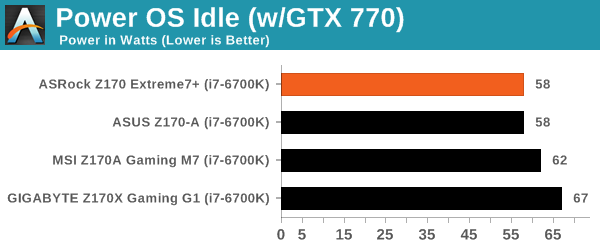
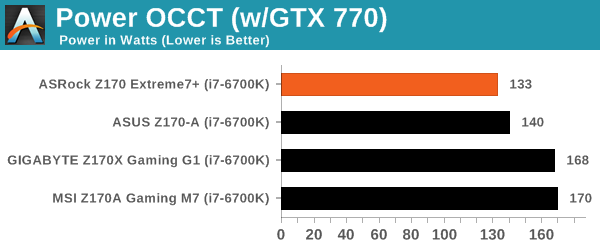
While the ASRock was not strictly the lowest consumer of power at idle, when we look at the idle to load differential, it shows a 73W gain for the i7-6700K, compared to the 110W seen on the MSI. This is in part because we saw a number of the early motherboard BIOSes overestimate the load voltage required at stock, as well as an element of MultiCore Turbo keeping voltages high. But in this case, because the ASRock does not have multicore turbo, it saves power at the wall.
Non UEFI POST Time
Different motherboards have different POST sequences before an operating system is initialized. A lot of this is dependent on the board itself, and POST boot time is determined by the controllers on board (and the sequence of how those extras are organized). As part of our testing, we look at the POST Boot Time using a stopwatch. This is the time from pressing the ON button on the computer to when Windows 7 starts loading. (We discount Windows loading as it is highly variable given Windows specific features.)
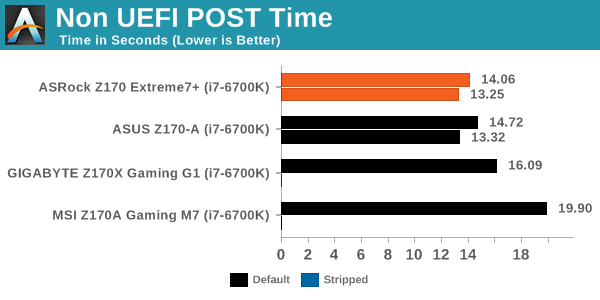
Because this is still early days for the Z170 platform, POST times are seemingly all over the place as motherboard manufacturers optimize their boot routines. Nevertheless, the ASRock comes out on top in its default setting, over the ASUS, GIGABYTE and way ahead of the MSI.
Rightmark Audio Analyzer 6.2.5
Rightmark:AA indicates how well the sound system is built and isolated from electrical interference (either internally or externally). For this test we connect the Line Out to the Line In using a short six inch 3.5mm to 3.5mm high-quality jack, turn the OS speaker volume to 100%, and run the Rightmark default test suite at 192 kHz, 24-bit. The OS is tuned to 192 kHz/24-bit input and output, and the Line-In volume is adjusted until we have the best RMAA value in the mini-pretest. We look specifically at the Dynamic Range of the audio codec used on board, as well as the Total Harmonic Distortion + Noise.

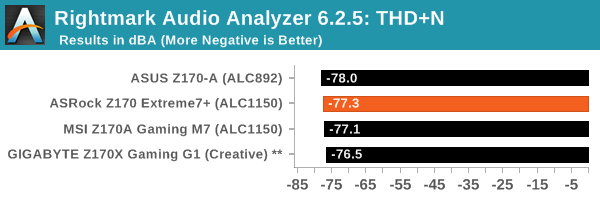
Using the ALC1150 and an improved design should put the ASRock implementation near the top for audio, and the -103 dBA result for SNR shows it.
USB Backup
For this benchmark, we transfer a set size of files from the SSD to the USB drive using DiskBench, which monitors the time taken to transfer. The files transferred are a 1.52 GB set of 2867 files across 320 folders – 95% of these files are small typical website files, and the rest (90% of the size) are small 30 second HD videos. In an update to pre-Z87 testing, we also run MaxCPU to load up one of the threads during the test which improves general performance up to 15% by causing all the internal pathways to run at full speed.
Due to the introduction of USB 3.1, as of June 2015 we are adjusting our test to use a dual mSATA USB 3.1 Type-C device which should be capable of saturating both USB 3.0 and USB 3.1 connections. We still use the same data set as before, but now use the new device. Results are shown as seconds taken to complete the data transfer.
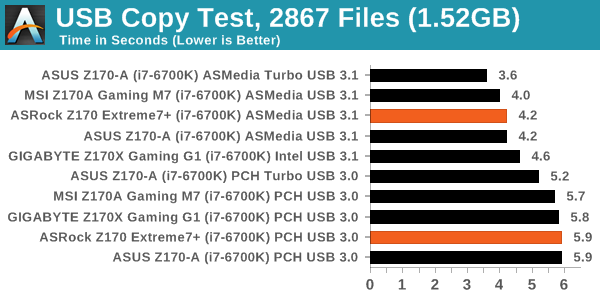
Like most of the USB 3.1 enabled motherboards on launch day, the ASMedia controller for the USB ports performs well although there does seem to see some variation in results as this is also optimized in firmware and drivers.
DPC Latency
Deferred Procedure Call latency is a way in which Windows handles interrupt servicing. In order to wait for a processor to acknowledge the request, the system will queue all interrupt requests by priority. Critical interrupts will be handled as soon as possible, whereas lesser priority requests such as audio will be further down the line. If the audio device requires data, it will have to wait until the request is processed before the buffer is filled.
If the device drivers of higher priority components in a system are poorly implemented, this can cause delays in request scheduling and process time. This can lead to an empty audio buffer and characteristic audible pauses, pops and clicks. The DPC latency checker measures how much time is taken processing DPCs from driver invocation. The lower the value will result in better audio transfer at smaller buffer sizes. Results are measured in microseconds.

For whatever reason, our DPC result came back rather poorly here. We’re not sure if it’s just a BIOS not set up for DPC Latency, or something more fundamental. As time goes on and the platform matures, we’ll see more motherboards underneath 100.










63 Comments
View All Comments
DanNeely - Monday, November 30, 2015 - link
Immediate availability isn't a concern, and I'd rather have a 2x type C model anyway (Asus has announced one, but it's a 5.25" bay enclosure for a full height expansion card making it a bit of a WTF); I probably won't have a USB-C device until late summer/early fall of next year.If these can be made usable with Haswell at all is a bigger concern for me. I know I'd be bandwidth limited and only able to hit max speed on one port if the second is idle; but that's a limitation I could live with.
pedjache - Monday, November 30, 2015 - link
It's actually ASmedia controller that drives the front panel, so apart from the fact that using SATAexpress will probably disable 2 of your SATA ports, I see no other concern on usability with haswell.nunya112 - Friday, November 27, 2015 - link
how many layers in the motherboard? is there copper etc.??ASROCK interests me, as they are better priced. if they start to have better components etc. and now the only issue I have is the motherboards are usually thin, and quite flexible
extide - Monday, November 30, 2015 - link
Why do you care about the # of layers? Do you mistakenly think that more is better?tuxRoller - Saturday, November 28, 2015 - link
How many samples did you use to determine that dpc time?careyd - Saturday, November 28, 2015 - link
Ian, love the article, read every word, studied every chart. Desperate to see the headline feature of triple M2 RAID benchmarked. Preferably with Samsung 950's, since I think adapting to the Intel 750's is a lot less elegant despite the possibility of greater performance. This type of arrangement should saturate anyway. But want to see throughput and IOPS numbers. Also, if this beggar can be a chooser, I'd love to see benchmarkes of two of the M.2's striped, with a third running solo. I could envision a number of reasons why this configuration might be a preferable, having a solo M.2 for system drive and the striped pair for other data intensive tasks/media/etc. I think it would make a heck of a cache drive for Adobe After Effects.TesseractOrion - Sunday, November 29, 2015 - link
I think I'd choose striped for OS, solo for redundancy instead, I'd want the OS to be as responsive as humanly (computerly) possible.jasonelmore - Sunday, November 29, 2015 - link
what a waste. the OS is never going to need 2.1GB Per second write and reads. Only a scratch disk or video editing app would use it, then you might as well use careyd configurationmurak01 - Sunday, November 29, 2015 - link
A few tests with three 950 Pro in RAID0 would be interesting. Thanks for a good review!Reflex - Sunday, November 29, 2015 - link
Right now you can pick up 250GB Samsung 850 EVO M.2 SSD's for only $79 at Newegg and Amazon. Given that this board is $220, dropping $240 on storage is not ridiculous and should perform exceptionally well.